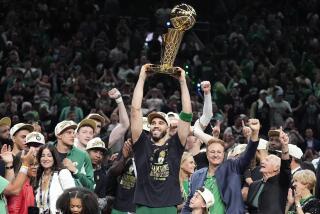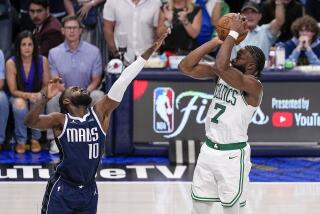It wasn’t about rings
- Share via
The titles were easier to win than the rings.
Frank Ramsey was a Hall of Fame forward on the Boston Celtics in the 1950s and ‘60s, an era when Bill Russell ruled in the paint and the Celtics won 11 NBA titles in 13 years.
Ramsey played on seven Celtics title teams -- he got only one championship ring.
“There wasn’t enough money to buy them,” he said.
For most of this period, the Celtics gave out rings only to players winning their first championship. The rest of the squad got cuff links, goblets, captain’s chairs, or pendants with a shamrock and a little diamond. “My wife and daughter wore the pendants,” Ramsey said.
When the Celtics won their first title in 1957, Ramsey’s playoff check was $1,500. “That helped you get through the summer and buy groceries,” he recalled.
Forty or 50 years ago, even players on championship teams had to take summer jobs to pay their bills. Contrast that to last year’s Spurs championship team that received $2.5 million in bonus money for its players and support staff. This season the average NBA player salary is $5.4 million, which means after a week or two off they can train all summer.
Ramsey, 76, now a bank president in Dixon, Ky., has a businessman’s eye and knows that when he played in the NBA it was merely a secondary league and the owners were a threadbare lot.
Red Auerbach, the Celtics’ coach and general manager, drafted Ramsey and offered him a $6,000 rookie contract. Ramsey wanted $8,500 and said he’d rather go in the Army. Auerbach offered $8,000 and Ramsey signed.
“We didn’t have many sellouts till the playoffs started because Boston was a hockey town,” Ramsey said.
After his rookie season, Ramsey would sign a blank contract before leaving town and the owner would later tell him what he was going to make the next season.
Back then the NBA was an eight-team league, with teams in Syracuse, St. Louis and a club in Minneapolis called the Lakers. To draw extra fans, sometimes there were doubleheaders: two out-of-town teams played the first game, then the Celtics played another team in the nightcap. Rival teams flew on the same commercial flights. Players shared hotel rooms and their meal money was $7 a day.
Tom Heinsohn, a Hall of Fame forward, played nine seasons and won eight titles. His top salary was $28,500. He quit at 30 because he had nagging injuries and took over an insurance agency.
With the Celtics, the mantra was titles first, money second.
Larry Siegfried was a shooting guard on five Celtics title teams, including Russell’s last year in 1969 when they beat the Lakers and Jerry West at the Forum in Game 7.
“Red’s theory was there was not any kind of individual incentive program or bonuses in contracts. Your bonus was your playoff check,” Siegfried said.
Even though the Celtics were usually the last team standing when their season ended in April or May, the players had to find summer jobs. Ramsey worked on a farm or in construction. Heinsohn sold insurance. Bob Cousy ran basketball camps for kids. Jim Loscutoff, a burly Celtics forward, was a golf pro.
Of all the Celtics, Gene Conley, a 6-8 backup forward and center who played on three championship teams, had the most unusual summer job: He pitched in the big leagues.
Conley’s first year in the majors was 1952, when he pitched for the Braves. That fall he joined the Celtics for the ‘52-’53 season, but his rookie pay was only $4,500. Walter Brown, the Celtics owner, told him the Celtics’ entire payroll the previous season had been $87,000, Conley remembers.
After one NBA season, Conley gave up on the new league because it didn’t pay enough.
By 1958 his baseball salary was $20,000. That fall he and his wife were building a house in Wisconsin, but they had three kids and were short of cash. So after five years out of the NBA, Conley decided, “basketball wasn’t a bad idea.”
Conley tried out for the Celtics and thought he’d struck a deal with the owner to match his baseball salary.
Auerbach said they wanted him, but they couldn’t afford him and sent him home. A few days later Auerbach offered him $10,000 to play. Conley took it. That ‘58-’59 season the Celtics swept the Minneapolis Lakers in the NBA Finals, and Conley got his one ring. He played two more seasons for the Celtics and his annual salary rose to $20,000, still less than the $25,000 he was earning by then with the Boston Red Sox.
Each spring the turnaround between his two sports was frantic. “When we were in the playoffs and I was running around in my shorts, the Red Sox had already finished spring training and were about 10 or 15 games into the season,” Conley said.
After the Celtics won another title he’d rush to Florida, put on his spikes “and work out with some old players and play pepper for eight or 10 days. Then I’d call the Red Sox and tell them I was ready to go, and as soon as I got here they’d pitch me,” he said.
At least Conley was playing.
Ramsey said he didn’t touch a basketball after the Celtics season ended till training camp in September.
“I had a job on a farm or construction. I got up at 4 a.m., I worked and I went to bed early. I had three kids. I was just trying to survive. I didn’t have time to play ball,” he said.
--
More to Read
Go beyond the scoreboard
Get the latest on L.A.'s teams in the daily Sports Report newsletter.
You may occasionally receive promotional content from the Los Angeles Times.











